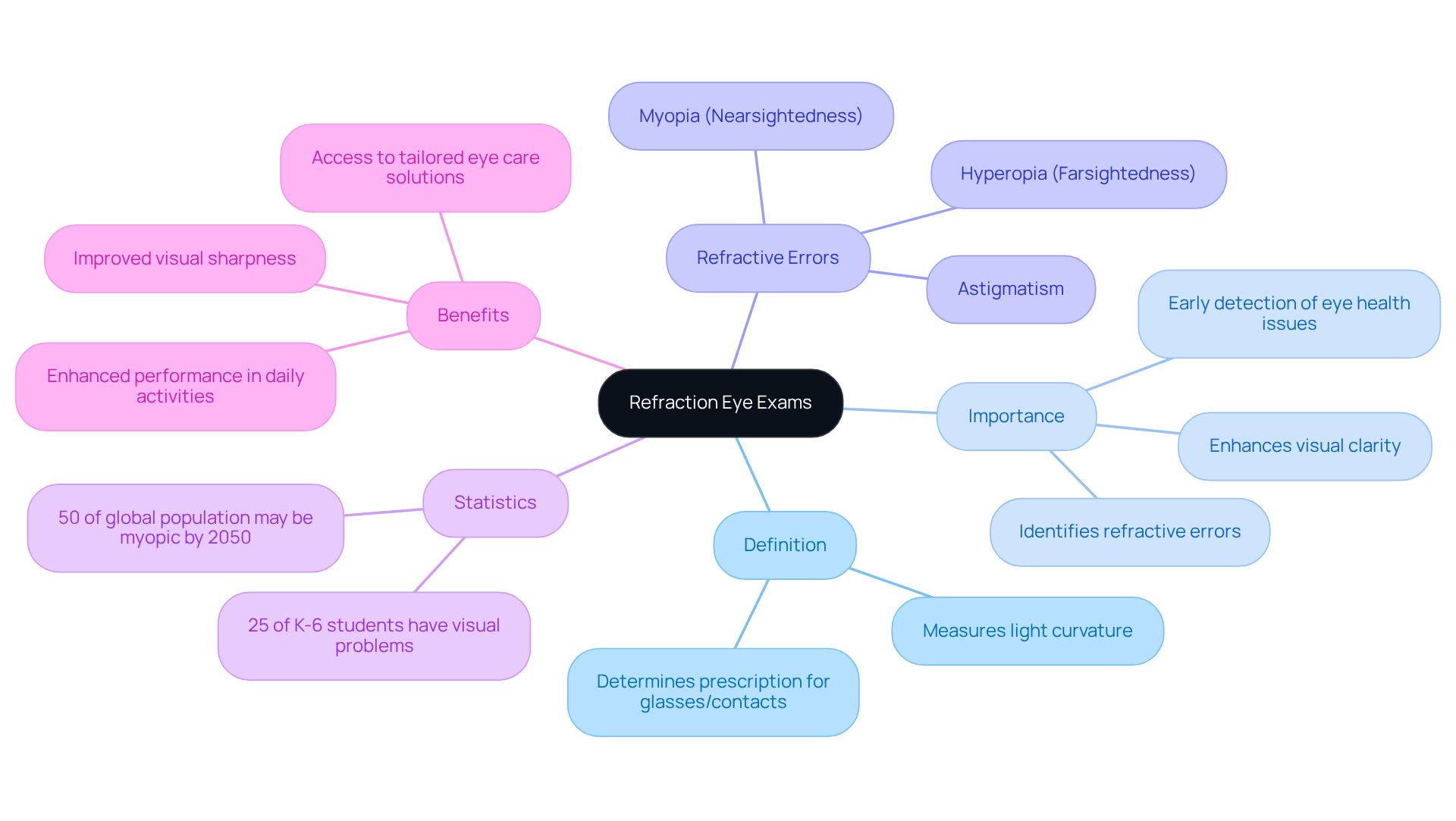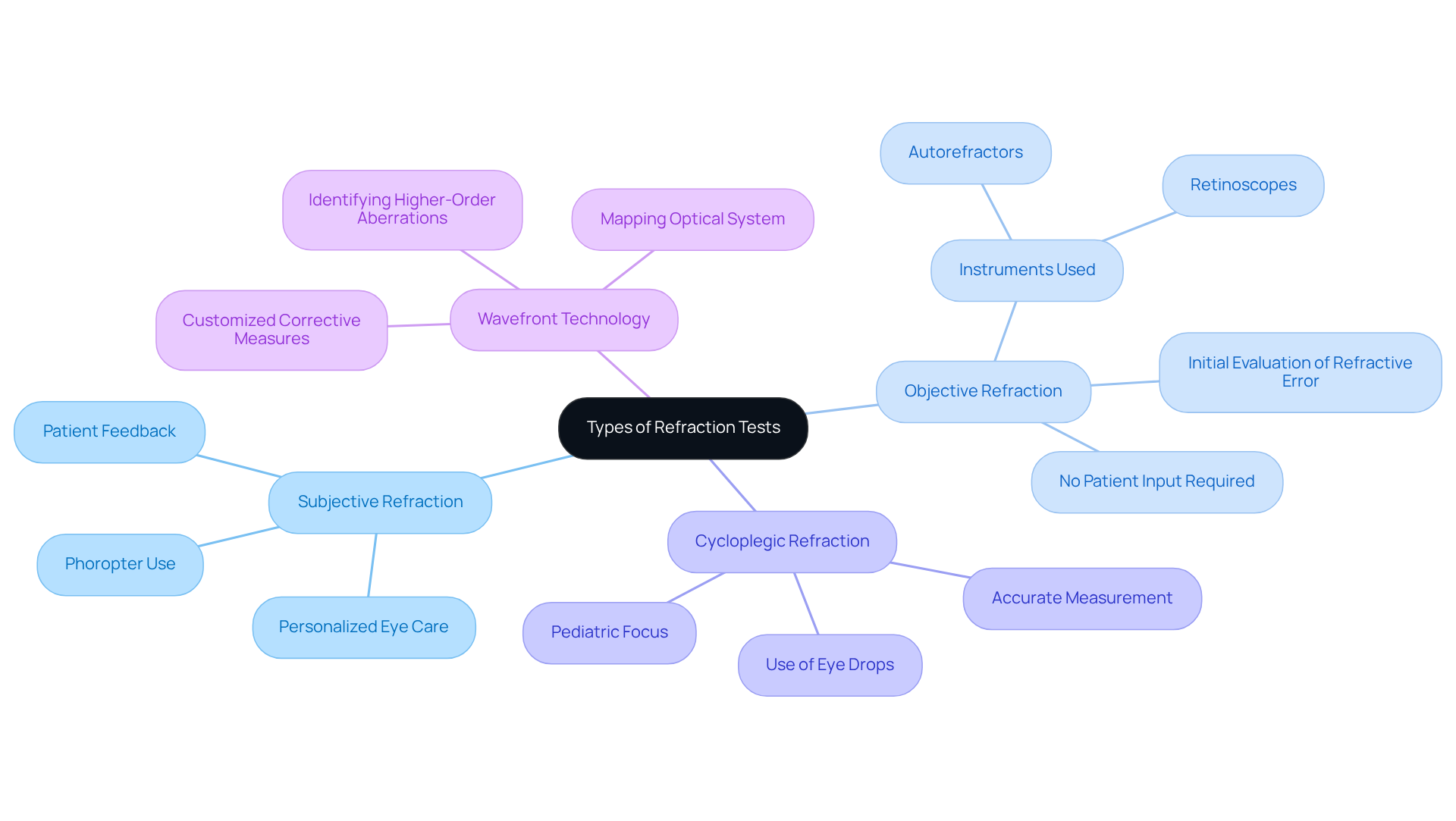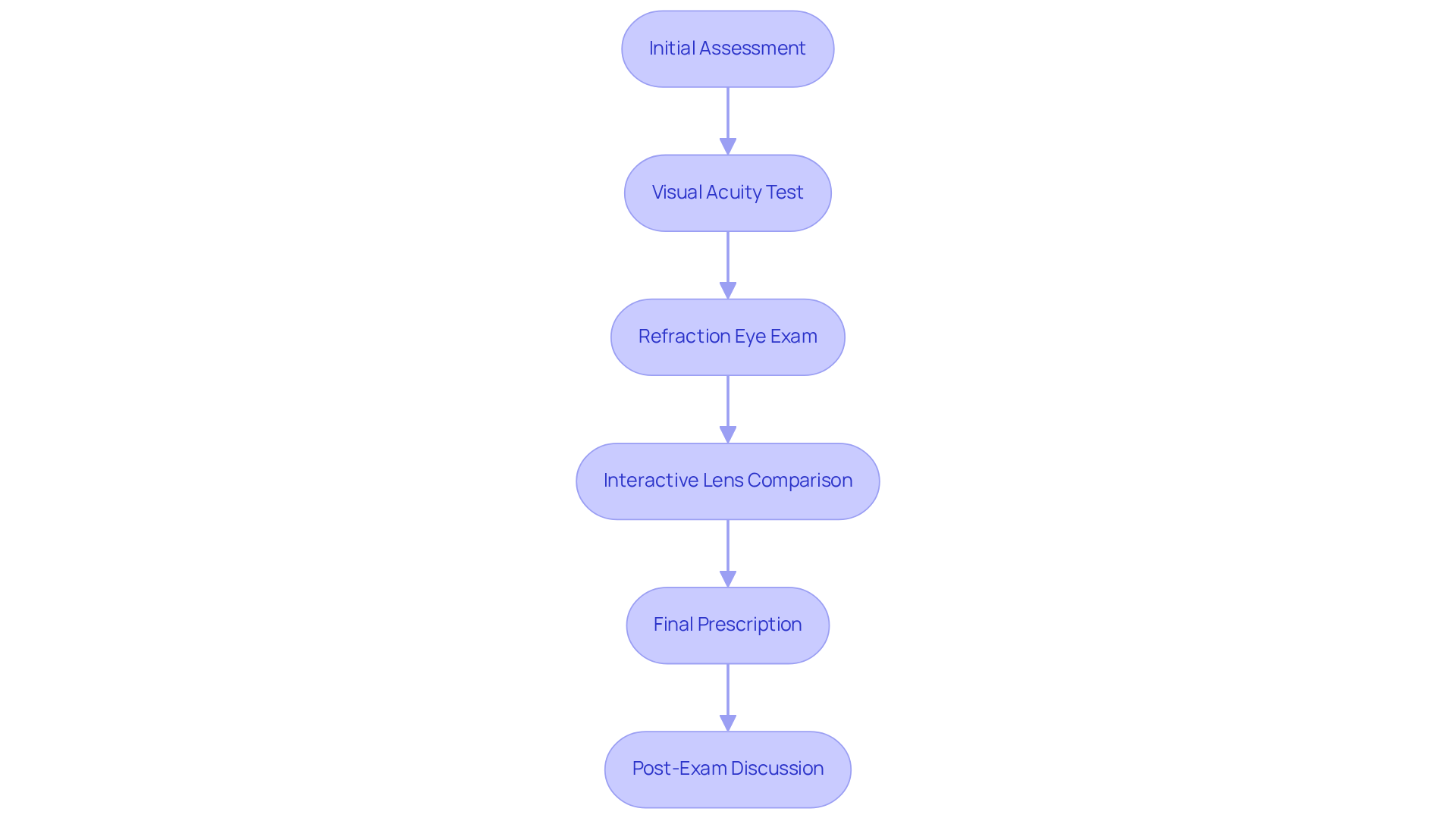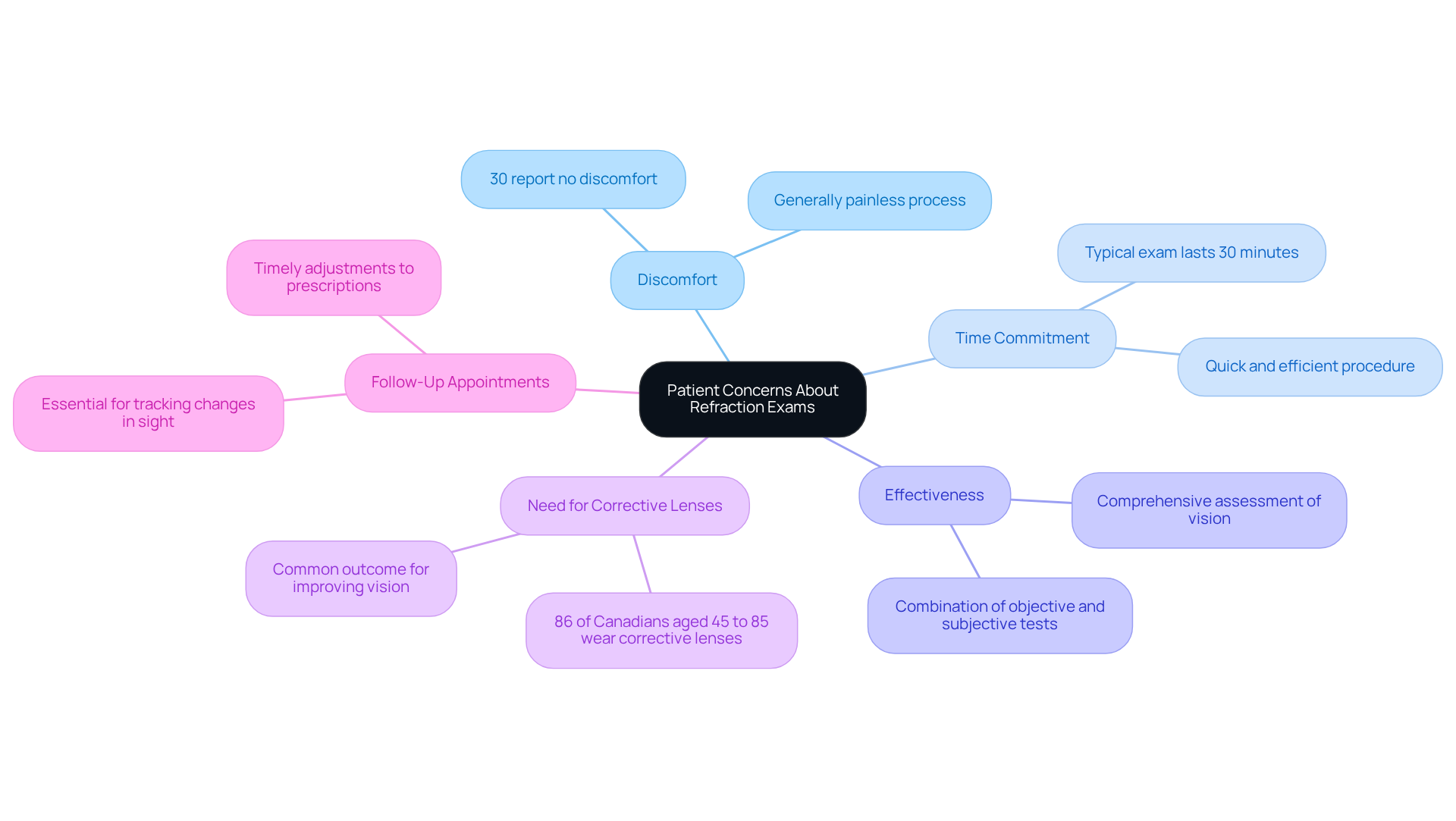Posted by: Northwest Eye in General on July 23, 2025
Overview
This article highlights the significance of mastering the refraction eye exam process to enhance your vision. We understand that these exams can feel daunting, but they are essential for accurately diagnosing refractive errors. By ensuring you receive the correct prescriptions for corrective lenses, these exams ultimately improve your visual clarity and overall quality of life.
It’s common to feel uncertain about what to expect during the process. However, knowing that these exams play a crucial role in your eye health can provide some reassurance. We are here to help you through this journey, ensuring you feel supported every step of the way.
Remember, taking care of your vision is an important aspect of your well-being. By prioritizing these exams, you are investing in a clearer, brighter future.
Introduction
Understanding the intricacies of vision care is crucial, especially regarding the pivotal role of refraction eye exams. We understand that navigating eye exams can feel daunting, but these assessments not only help in identifying common refractive errors; they also serve as a gateway to clearer vision and an improved quality of life. As the prevalence of vision issues continues to rise, many individuals wonder how to ensure they receive the most accurate prescriptions and optimal eye health. This article delves into the significance of refraction eye exams, the various testing methods available, and how to approach the experience with confidence and clarity.
Define Refraction Eye Exams and Their Importance
A comprehensive eye evaluation includes a vital component known as a . During a refraction eye exam, it measures how light curves as it enters your eye, helping to determine the correct prescription for glasses or contact lenses. This process is essential for identifying such as myopia (nearsightedness), hyperopia (farsightedness), and astigmatism through a refraction eye exam. Understanding these conditions allows eye care professionals to provide , greatly enhancing your visual clarity and overall quality of life.
We understand that can feel daunting, but they are crucial for preserving optimal sight. Age-related changes or health issues can , making these evaluations even more important. Statistics show that refractive errors are common; projections suggest that by 2050, 50% of the global population may be myopic. Furthermore, around 25% of students in grades K-6 face visual problems serious enough to hinder their learning. This underscores the and regular check-ups.
Regular eye exams, such as a refraction eye exam, do more than just prescribe the right lenses; they play a significant role in identifying potential eye health issues early on. Many individuals who undergo report , which can enhance their performance in daily activities and overall well-being. Expert opinions consistently emphasize the importance of these tests in managing eye health, reinforcing the need for prioritizing regular eye care.
We are here to help you navigate your options at Northwest Eye, making these . Understanding funding choices can alleviate financial concerns, ensuring you receive the necessary eye assessments and treatments. For instance, Medicare Part B may cover vision tests for patients with specific medical conditions, so it’s important to .
Remember, undetected refractive errors can lead to significant vision impairment. This highlights the critical role of routine vision assessments in maintaining your eye health. We encourage you to take this step towards better vision and overall health.

Explore Different Types of Refraction Tests
There are several types of , each serving a unique purpose in assessing vision. We understand that navigating these options can feel overwhelming, but knowing what to expect can help ease your concerns. The most common types include:
- : This traditional method involves you looking through a phoropter, a device that contains various lenses. Your eye specialist will ask you to compare different lens options, determining which offers the . This method relies on your feedback, making it a cornerstone of .
- : This technique uses instruments like retinoscopes or autorefractors to measure how light reflects off your retina. It provides an initial evaluation of refractive error without requiring your input. Research has shown that the mean spherical equivalent using autorefractors can vary, with values such as 7.93±3.38 for autorefractor 1, indicating its effectiveness in delivering accurate measurements.
- Cycloplegic Refraction: In this method, eye drops are used to temporarily paralyze your eye’s focusing muscles, allowing for a more accurate measurement of refractive error, especially in children. This approach is crucial in , as it helps prevent complications like amblyopia by ensuring precise assessments.
- : This advanced method maps your eye’s optical system, identifying that can affect vision quality beyond standard refractive errors. By providing a detailed analysis, wavefront technology enables customized corrective measures, enhancing overall visual outcomes. Understanding these higher-order aberrations is essential for optimizing your treatment plan.
Each of these tests, such as the refraction eye exam, plays a crucial role in ensuring that you receive the most for your vision needs. Remember, we are here to help you through this process, and your comfort and clarity are our top priorities.

Walk Through the Refraction Eye Exam Process
The process typically follows these steps:
- Initial Assessment: We understand that every individual’s journey begins with a and any current vision issues. Our eye care professionals are here to listen and address your concerns.
- : You will be asked to read letters from an eye chart. This step helps us determine your baseline visual acuity, and we know how important this clarity is to you.
- Refraction Eye Exam: The next step is to schedule a refraction eye exam. The refraction eye exam involves using a retinoscope or autorefractor to measure how light refracts through your eye. This provides us with initial data on your , reassuring you that you are in capable hands.
- Interactive Lens Comparison: The refraction eye exam is an important part of assessing vision. During the refraction eye exam, you will look through a phoropter and compare different lens options. You might be asked questions like ‘Which is better, one or two?’ This interactive process helps us refine your prescription, ensuring it meets your unique needs.
- Final Prescription: After determining the , we will provide a prescription for glasses or contact lenses. Our goal is to ensure it aligns perfectly with your visual needs, enhancing your daily life.
- Post-Exam Discussion: Finally, we will , addressing any questions or concerns you may have about your vision and the recommended . We want you to leave feeling informed and supported.
with are remarkably high. Many individuals appreciate the clarity and thoroughness of the process. As one eye care expert observed, “A properly performed vision test not only enhances sight but also enriches the overall experience for individuals, making them feel appreciated and comprehended.” This comprehensive approach ensures that you leave with a clear understanding of your vision and the steps needed to improve it.

Address Common Patient Concerns About Refraction Exams
We understand that patients often voice worries about , especially regarding discomfort levels. While some may be concerned about potential pain, the reality is that the process is generally painless. Most individuals indicate only feeling slight pressure when looking through the phoropter, and discomfort levels during these assessments are notably low. In fact, research shows that 30% of participants reported no eye discomfort during , reinforcing the idea that these evaluations are well-tolerated.
It’s common to feel apprehensive about the time commitment linked to the test. However, contrary to , a typical lasts about 30 minutes, making it a quick and efficient procedure. This efficiency is crucial, especially for those with busy schedules.
Patients may also question the effectiveness of the results. It is essential to understand that during the , the combination of objective and subjective tests provides a . This dual approach enhances the accuracy of the results, ensuring that individuals receive reliable information about their .
The prospect of needing glasses or contacts can feel daunting for many. However, it is important to recognize that this is a common outcome and a manageable solution for improving vision. In fact, approximately 86% of Canadians aged 45 to 85 wear corrective lenses, based on a study conducted from 2012 to 2015, highlighting the prevalence and normalcy of this need.
Finally, individuals frequently question the importance of . Routine eye assessments, including vision tests, are essential for tracking changes in sight and maintaining optimal eye wellness. These follow-ups allow for timely adjustments to prescriptions and help in the of potential eye conditions.
By addressing these concerns, we hope patients can approach their refraction eye exam with confidence, knowing they are taking an important step toward better vision.

Conclusion
Mastering the refraction eye exam process is crucial for anyone seeking to enhance their vision and overall eye health. We understand that this essential evaluation not only identifies refractive errors but also provides a tailored prescription for corrective lenses, significantly improving your visual clarity. By recognizing the significance of regular eye exams, you can take proactive steps toward maintaining your sight and addressing any potential issues before they escalate.
Throughout this article, we’ve emphasized the importance of refraction eye exams, highlighting how these assessments can prevent vision impairment and improve your daily life. Various types of refraction tests, from subjective to advanced wavefront technology, have been explored, illustrating the comprehensive nature of the evaluation process. We also addressed common patient concerns surrounding discomfort, time commitment, and the necessity of follow-up appointments, reassuring you that these tests are not only manageable but also vital for your long-term eye health.
Ultimately, prioritizing regular refraction eye exams is an investment in your personal well-being. By taking the initiative to schedule these assessments, you can ensure that you receive the most accurate prescriptions, leading to clearer vision and a better quality of life. Embrace this opportunity for enhanced sight and make routine eye care a fundamental part of your health maintenance.
Frequently Asked Questions
What is a refraction eye exam?
A refraction eye exam is a comprehensive evaluation that measures how light curves as it enters your eye, helping to determine the correct prescription for glasses or contact lenses.
Why are refraction eye exams important?
Refraction eye exams are essential for identifying refractive errors such as myopia (nearsightedness), hyperopia (farsightedness), and astigmatism, allowing eye care professionals to provide personalized corrective lenses, which enhance visual clarity and overall quality of life.
How common are refractive errors?
Refractive errors are quite common; projections suggest that by 2050, 50% of the global population may be myopic, and around 25% of students in grades K-6 face visual problems serious enough to hinder their learning.
What additional benefits do regular eye exams provide?
Regular eye exams, including refraction eye exams, help identify potential eye health issues early on and can lead to improved visual sharpness, enhancing performance in daily activities and overall well-being.
How can financial concerns be addressed regarding eye exams?
Understanding funding choices can alleviate financial concerns. For example, Medicare Part B may cover vision tests for patients with specific medical conditions, making it important to understand your coverage options.
What can happen if refractive errors go undetected?
Undetected refractive errors can lead to significant vision impairment, highlighting the critical role of routine vision assessments in maintaining eye health.






